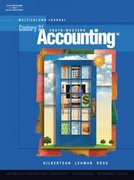Question
On January 1, 2016, Knorr Corporation issued $700,000 of 6%, 5-year bonds dated January 1, 2016. The bonds pay interest annually on December 31. The
On January 1, 2016, Knorr Corporation issued $700,000 of 6%, 5-year bonds dated January 1, 2016. The bonds pay interest annually on December 31. The bonds were issued to yield 7%. Bond issue costs associated with the bonds totaled $8,312.46.
Required:
Prepare the journal entries to record the following:January 1, 2016Sold the bonds at an effective rate of 7%December 31, 2016First interest payment using the effective interest methodDecember 31, 2016Amortization of bond issue costs using the straight-line methodDecember 31, 2017Second interest payment using the effective interest methodDecember 31, 2017Amortization of bond issue costs using the straight-line method
Prepare the journal entries to record the following:Additional Instructions
January 1, 2016Sold the bonds at an effective rate of 7%December 31, 2016First interest payment using the effective interest methodDecember 31, 2016Amortization of bond issue costs using the straight-line methodDecember 31, 2017Second interest payment using the effective interest methodDecember 31, 2017Amortization of bond issue costs using the straight-line method
How does grading work?
PAGE 2016PAGE 2017
GENERAL JOURNAL
Score:124/193
DATEACCOUNT TITLEPOST. REF.DEBITCREDIT1
2
3
4
5
6
7
8
9
10
Points:
23.13 / 36
Feedback
Check My Work
1.Jan. 1, 2016: You should calculate the selling price of the bond by summing the present value of the principal and interest payments discounted at the effective interest (yield) rate. At the time of issue, the issuing company records the face value of bonds in a Bonds Payable account and the proceeds received as a debit to the Cash account. When bonds are issued with a contract interest rate below the effective interest rate the issuer will record a discount in a separate account titled Discount on Bonds Payable. GAAP requires that a company capitalize as an asset any costs connected with a bond issue (such as legal and accounting fees, printing costs, or registration fees).2.Dec. 31, 2016 - Annual interest: You should compute the effective interest expense amount as follows (Interest Expense = Effective Interest Rate x Book Value at Beginning of Period). A portion of the bond discount or premium is amortized, and this amortization is the difference between the amount of interest expense and the cash payment.3.Dec. 31, 2016 - Bond issue cost: Bond issue costs are usually amortized over the life of the bond issue by the straight-line method. You should debit Interest Expense.4.Dec. 31, 2017 - Annual interest: You should compute the effective interest expense amount as follows (Interest Expense = Effective Interest Rate x Book Value at Beginning of Period). A portion of the bond discount or premium is amortized, and this amortization is the difference between the amount of interest expense and the cash payment.5.Dec. 31, 2017 - Bond issue cost: Bond issue costs are usually amortized over the life of the bond issue by the straight-line method. You should debit Interest Expense.
Step by Step Solution
There are 3 Steps involved in it
Step: 1

Get Instant Access to Expert-Tailored Solutions
See step-by-step solutions with expert insights and AI powered tools for academic success
Step: 2

Step: 3

Ace Your Homework with AI
Get the answers you need in no time with our AI-driven, step-by-step assistance
Get Started


